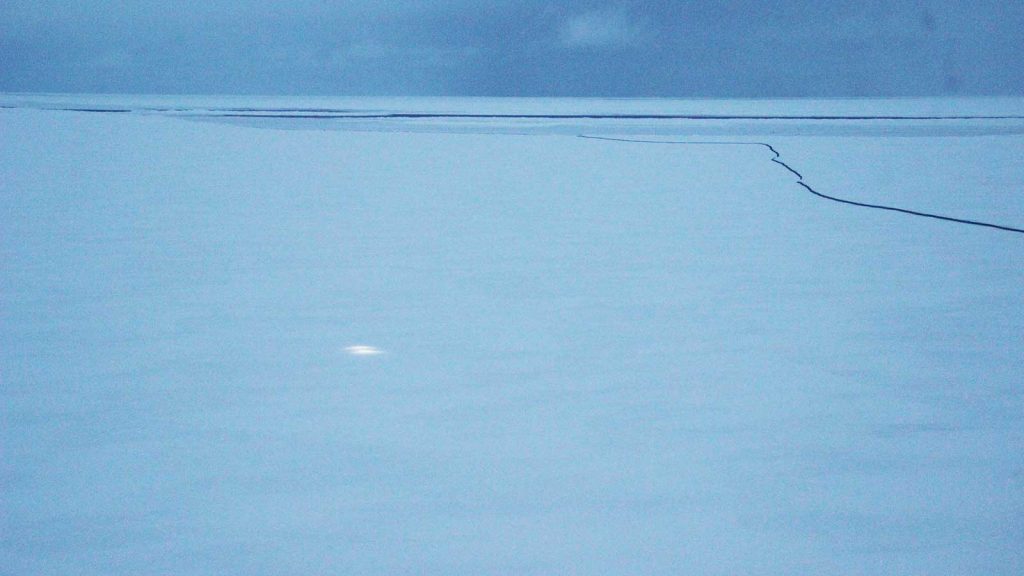
The moment we realized all was not well. NUI lit up the ice under the bow of the ship as it slid silently by and headed off to port, away from where it was supposed to be. It never even acknowledged we were there. Is it just being a moody teenager? (photo by Chris German, Woods Hole Oceanographic Institution)
NUI is back on deck after Dive 15 and it was a success. Mostly.
Friday began with a 5:00 a.m. start for the NUI team, because they really, truly, absolutely, positively assured me that after Dive 14 there was no need for them to start work at 4:00 a.m. every again, to be ready for an 8:00 launch. ☺
I believed them and all was going well, until it wasn’t. ☹
At 7:00 a.m., the news came that they needed me to advise the bridge that we would have to delay launch until 9:00. ☹
But at least that left time for breakfast. ☺
Back on deck at 9:00, the crew showed up and we got ready to launch. At the chief mate’s request, I was out on deck with my camera taking photos from every possible angle to capture all the elements to a NUI launch so that we could write up our methods for a ship’s “Einsatzplan,” which gave me a good excuse to watch the launch up close. ☺
But at 9:10 a.m., as we prepared to lower our acoustic beacon system over the back of the ship, we found that the ship’s cable we were using had been damaged during a different operation using the same cable the night before. ☹ Happily, I was told it only needed 20 minutes to repair and, since I was out on deck, I got to see sunrise and sunset all at the same time. ☺
Although the official weather charts show that there is no sunrise or sunset anymore at this latitude, that is based on whether the whole of the sun rises above the horizon. We do still get to see parts of the sun briefly, if the clouds and fog and poor visibility ever allows, and this was one of those rare occasions with light glinting on a river-like thread of open water through the ice. It was quite beautiful. ☺
After the light show, I went inside and learned the cable repairs would actually need an extra hour, which meant a 2.5-hour delay to the dive, the final of 3 missions planned, which left no time for 3D photographs with the camera Mike borrowed from his friends at the Australian Center for Field Robotics. ☹
Finally, it was 10:30 a.m. and, 5.5 hours after starting our day, NUI was in the water and off to the seafloor. ☺
Our next milestone came at 12:30 p.m., when we completed the first mapping box for the area where Antje and her biology colleagues had been collecting giant sponge samples. I checked in with Antje and she confirmed that she had secured us an extra hour of dive time, so I headed back to ask Mike if we could stay down longer in order to do some photography as well as mapping, even though that would mean a long day for the NUI team. ☺
1:40 p.m.: NUI completed a 2.5-kilometer (1.5-mile) drive from Antje’s area to the area that I was more interested in and started conducting the mapping work that I wanted to get out of this dive.☺ That meant it was time to haul up our navigation equipment and move the ship closer to where NUI was working so we could be in place for the recovery.
2:30 p.m.: We were stuck in the ice and still trying to get within 1 kilometer (0.6 mile) of NUI, but the location above NUI was occupied by a 3 kilometer (1.8 mile) wide, 2 meter (6 foot) thick ice floe and Polarstern could get there. This, despite that fact that Holger, the officer on watch, had called up a third engine and attacked the problem at ramming speed, which was fun to watch. ☺
3:30 p.m.: After surveying the scene, Holger and I spotted a potential weak “underbelly” to the ice floe, so we took a mile-long detour to the northeast, then hung a hard left and splintered our way to within 900 meters (3,000 feet) of our target, which was good enough. ☺
4:15 p.m.: With the acoustic devices back in the water, we reestablished contact with NUI, which had finished both mapping surveys planned for today’s dive and had moved on to taking photos of the seafloor. ☺
4:50 p.m.: The first set of photos was complete and Mike was happy enough with the vehicle to let us begin the second, which we should have been able to complete by 5:30. ☺
5:25 p.m.: With 90 percent of the final photo survey complete, NUI’s battery levels dropped below 40 percent, which meant it was time to come home. ☹ But we had achieved a lot, so we weren’t too unhappy. ☺
5:30 p.m.: On the bridge waiting for NUI to come up, I had a friendly chat with the captain that brought back good memories of my family and colleagues. ☺
6:00 p.m.: Still on the bridge with the captain looking for NUI. ☹
6:30 p.m.: We spotted NUI lighting up the underside of the ice just where it was supposed to be, 200 meters (660 feet) to starboard in line with the crane that was ready to pluck it from the ocean. ☺
7:00 p.m.: Instead of coming directly to the ship the way it was supposed, NUI began moving slowly forward and left under the ice sending it right under the bow of the ship. ☹
7:05 p.m.: Mike arrived on the bridge and confirmed that they could not stop NUI because it wasn’t listening to instructions, so we watched, helpless, as the lights drifted past the front of the ship and off to port toward what we knew was increasingly thick ice cover. ☹
7:30 p.m.: Louis called from the control room to tell us that he managed to make contact with NUI wirelessly and told it to drive itself hard against the underside of the ice so that it would get stuck and we wouldn’t lose track of it. ☺
7:45 p.m.: The captain and Mike agreed on a plan: Mike and the ice physics team would launch a rescue party, who would walk out on the thick ice, drill a hole down to NUI, attach some floats and then return to the ship. The captain would then use the Polarstern to break the ice around NUI and flush it out. ☺
8:30 p.m.: Maren translated a radio conversation between the captain and Marcel, head of the ice party, in which Marcel reported that the floats were attached to NUI. The the captain then asked the team to attach a line to NUI, as well, so everyone had to stay out on the ice while the captain turned the ship around and backed up to get ship and NUI aligned just so. ☹
10:30 p.m.: Everybody was safely back aboard the ship. ☺
11:00 p.m.: NUI was finally hoisted back aboard the ship. ☺
6:00-11:00 p.m.: I felt really bad for messing the captain around for five hours (neither of us left the bridge the whole time), as well as the fact that me bringing NUI to sea has, today, messed up Antje’s science planning for the whole evening and caused other stations to be cancelled. ☹☹☹☹☹
11:05 p.m.: I thank the captain for all his efforts, and he is gracious enough to give me a pat on the shoulder in reply, as if to say, “Don’t worry about it, these things happen.” He is a very nice man. ☺
11:15 p.m.: NUI is safely back in the hangar. ☺
11:20 p.m.: Stefano confirmed that both the mapping and camera surveys seem to have worked. We haven’t see the actual data, but there are a lot more 1’s and 0’s on the hard drive than when it headed to the seafloor this morning. ☺
11:30 p.m.: The kitchen crew saved dinner for us. ☺
12:30 a.m.: Time for bed. ☺
09:00 a.m.: The next day (Saturday). NUI collected nearly two hours of photos of the seafloor that I now get to look at and also made detailed maps of the two areas we were interested in ☺☺☺
Conclusion: NUI is entering its teenage years. It’s still basically a good kid, but it’s inclined to stay out later than we agreed without checking in with home on a Friday night.
Response: NUI is grounded for the rest of the weekend.

